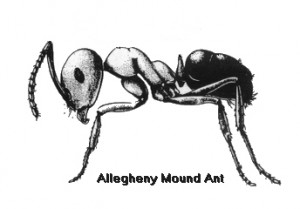READY TO GET STARTED?
REQUEST A FREE ESTIMATE
Fill out the form below or call (888) 466-7849 for a free, no-obligation estimate.
 The allegheny mound ant is a common ant found outdoors. They feed on small insects or arthropods that are found outside so they rarely have a need to make their way into a structure…but that doesn’t mean you will never find them inside.
The allegheny mound ant is a common ant found outdoors. They feed on small insects or arthropods that are found outside so they rarely have a need to make their way into a structure…but that doesn’t mean you will never find them inside.
Identification:
The Mound:
The allegheny mound ant is known for the large mounds that they build. This is the easiest way to identify the species. Their mounds are made up of built up soil that can go up to 4 feet above soil and extend 3 feet deep into the ground. A 5 month old mound can be about 2 feet wide and 8 inches tall. A two year old mound can be up to 3 feet tall. These large mounds are mostly found in unkept grassy areas, pastures, nurseries, and turf.
Allegheny mound ants produce formic acid that can damage bushes, plants, and gardens. Formic acid can kill small trees and shrubs within 40-50 feet of a mound and the grass of your lawn that is located around a mound. Most new mounds are made in late May and early June. This can cause issues if you spend time in your lawn because the mound ants will bite if they feel like their colony is being disturbed.
Protect yourself and your lawn by hiring a professional exterminator that can eliminate ants around your home and prevent damage and harmful bites. Call Northwest Exterminating to get rid of your ant problems.
Disclaimer: These tips are general medical information and do not constitute medical advice. Please contact your physician for information about yourself or your family member.
How do I know if I, or my child, has an allergy to mosquitoes?
Usually people who ask this question already suspect they have an allergy to mosquito bites. When they get bitten they get large swollen bumps that are red, itchy and painful. These bumps tend to last longer than mosquito bites for other people and they cause more discomfort. The reaction may not be classified as a true “allergy” but the problem is a larger release of histamine and other immunoglobulins that cause inflammation.
These people have a more severe reaction to the proteins that mosquitoes inject into the bite to keep the blood from clotting. The reaction is usually a large red whelp that itches, swells and is very uncomfortable. Although these bites are very irritating, it is rare to have a serious allergic reaction to a mosquito bite. Life threatening reactions would include difficulty breathing, low blood pressure, fainting or swelling all over.
If you or your child has a more severe reaction to mosquito bites than others, you may have what is known as the “Skeeter Syndrome.” People that have the “Skeeter Syndrome” have more severe reactions and will have larger, itchier and more painful bumps associated with the bites. The bites can also cause blisters and be associated with infections if the bites are scratched until they are open and bleeding. True mosquito allergies can be diagnosed with allergy testing.
What to do if you are allergic?
The first thing to do is to avoid the mosquito bites in the first place. Have Northwest Exterminating, or your local exterminator, provide your home with a mosquito treatment. Also, cover your body when you go out and use an insect repellent, such as DEET.
If you do get bitten, you can use an anti-histamine like Diphenhydramine (Benadryl) for the itching. You can take the anti-histamine by mouth or use preparations that can be placed topically on the bite. Anti-inflammatory creams like hydrocortisone may also be used. If the bite is scratched open, you will want to wash it daily and apply an antibiotic ointment to keep them from being infected.
If you have severe allergic symptoms like respiratory distress, swelling of the body, face, mouth or throat you will need to go directly to the emergency department.
Do you have a question for Dr. Goo? Click HERE to submit your question.
Disclaimer: These tips are general medical information and do not constitute medical advice. Please contact your physician for information about yourself or your family member.
How do I know if I, or my child, has an allergy to mosquitoes?
Usually people who ask this question already suspect they have an allergy to mosquito bites. When they get bitten they get large swollen bumps that are red, itchy and painful. These bumps tend to last longer than mosquito bites for other people and they cause more discomfort. The reaction may not be classified as a true “allergy” but the problem is a larger release of histamine and other immunoglobulins that cause inflammation.
These people have a more severe reaction to the proteins that mosquitoes inject into the bite to keep the blood from clotting. The reaction is usually a large red whelp that itches, swells and is very uncomfortable. Although these bites are very irritating, it is rare to have a serious allergic reaction to a mosquito bite. Life threatening reactions would include difficulty breathing, low blood pressure, fainting or swelling all over.
If you or your child has a more severe reaction to mosquito bites than others, you may have what is known as the “Skeeter Syndrome.” People that have the “Skeeter Syndrome” have more severe reactions and will have larger, itchier and more painful bumps associated with the bites. The bites can also cause blisters and be associated with infections if the bites are scratched until they are open and bleeding. True mosquito allergies can be diagnosed with allergy testing.
What to do if you are allergic?
The first thing to do is to avoid the mosquito bites in the first place. Have Northwest Exterminating, or your local exterminator, provide your home with a mosquito treatment. Also, cover your body when you go out and use an insect repellent, such as DEET.
If you do get bitten, you can use an anti-histamine like Diphenhydramine (Benadryl) for the itching. You can take the anti-histamine by mouth or use preparations that can be placed topically on the bite. Anti-inflammatory creams like hydrocortisone may also be used. If the bite is scratched open, you will want to wash it daily and apply an antibiotic ointment to keep them from being infected.
If you have severe allergic symptoms like respiratory distress, swelling of the body, face, mouth or throat you will need to go directly to the emergency department.
Thanks,
Dr. Goo

Do you have a question for Dr. Goo? Click HERE to submit your question.
We’re all aware of the annoyance and health concerns that come along with mosquitoes. But there is a similar bug that can be just as annoying to those residents living in areas where sand is found, the sand gnat. The sand gnat (also known as sand fly or no see um) flies, bites, and sucks blood just like the mosquito. Sand gnats leave behind red, itchy bumps on the skin after they have fed off of your blood. It is not unusual for the effects of a sand gnat bite to be more intense and last for a longer period of time than a mosquito bite. Like mosquito bites, these bumps can become infected or cause a rash.
Sand gnats are a major concern to our customers living in Savannah and the surrounding areas. By being proactive, you can ensure that mosquitoes and sand gnats don’t invade your yard. Our Savannah service center offers a Green Mosquito & Sand Gnat Program to reduce the annoyance of these pests while still using the lowest environmental impact possible. To ensure that our mosquito control program is effective and environmentally friendly, we use products that are derived from flowers and bacteria.
For pest, mosquitoes, and sand gnat control in Savannah, call Northwest Exterminating. Visit us online for more information at www.callnorthwest.com.
Did you know: Sand gnats are so notorious in Savannah that the city has a minor league baseball team named after them, the Savannah Sand Gnats.
What are the tiny red bugs crawling around my windows?
This is a common question that we get in early spring and late fall. Clover mites are found in warm, sunny places which is why you usually see them around your windows and crawling on your curtains. Clover mites are smaller than the tip of a pencil which allows them to fit into the smallest cracks and crevices around a structure. They are oval shaped with 8 legs. Their 2 front legs are longer than the rest and protrude forward which can be confused with antennae.
Clover mites can be alarming to homeowners because they gather in large numbers but there is no need for alarm. Clover mites do not bite or carry diseases, however they can cause skin irritation to some with sensitive skin. (These are not to be confused with chiggers which look similar but get into the skin and itch.) They do not damage furniture or pursue your food. Clover mite eggs lay dormant in the summer months and hatch in temperatures of 85 F or below. They are attracted to warm, sunny places which leads them to the windows in your home. Clover mites are often identified by the red stain they leave once they have been squashed. The red substance is the pigment in their color, not their blood. Grass and clovers are their main source of food.
There are simple ways to get rid of clover mites in your home. The best way is to vacuum them up. As with any vacuumed pest, make sure that you dispose of the bag immediately in an outdoor trash can. Disposing of the bag is always recommended but is especially an issue when it comes to clover mites because they are so small and can escape from the bag into your home. Another way to get rid of clover mites is to place sticky traps around your windows. As always, prevention is your best option. Clover mites feed on fertilized lawns, so if you are seeing an infestation cut back on the fertilizer. Remove grass that has direct contact to your structure. Instead, use soil, gravel, or mulch because clover mites have difficulty moving on bare, loose terrains. Make sure all window screens are tight fitting. Seal any cracks around the outside of the structure and use weather stripping on entrance areas.
If you are having a consistent problem with clover mites or other pests, it’s best to call Northwest Exterminating. We will ensure that your issue is identified and a customized plan is created for treatment of clover mites.
Are these small red bugs showing up in your home?